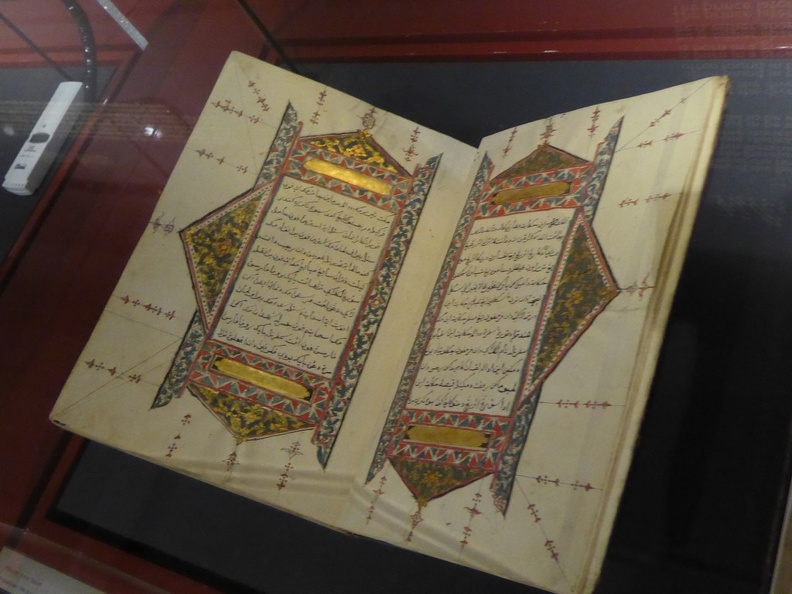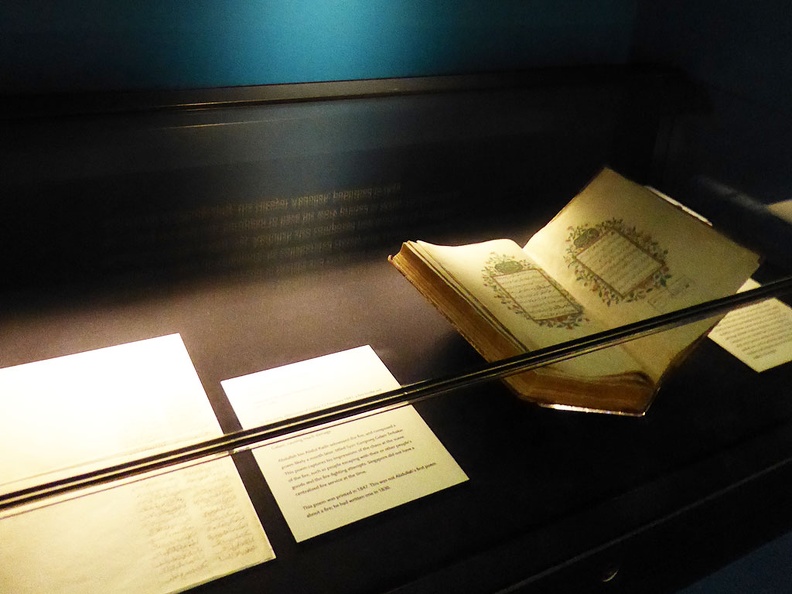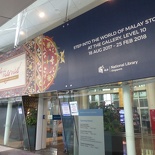Tucked in the upper levels of the Singapore National Library Board (NLB) building in Bugis is a treasure trove of Manuscripts and early Books documenting tales and early use of the Malay language. For centuries, even leading up to the 19th century, the Malay language was one of trade, diplomacy, religious discourse, and literature, particularly for maritime Southeast Asia. As such they are largely used to communicate intent not only between people but maritime ships. In addition, they provide for a means for archival and sharing of written information via texts on paper. Come the exhibition Tales Malay World Manuscripts and early Books.
The exhibition situated at the building’s level 10 gallery area runs from 18th August 2017 to 25th Feb 2018. In essence, the exhibition aims to showcase these rarely seen items, providing glimpses into the society that produced and read these literary works. Undoubtedly, you won’t miss the large promotional posters plastered all over the library main entrance. It beckons you of the treasures which awaits.
Up in the galleries, the exhibition space spans over 4 main sectors. The displays run in a linear fashion. You start off with an introductory hallway leading into a dimly lit hall full of glass displays. Each gallery houses a scripture of interest. Here are some notable scriptures:
Hikayat Isma Yatim
This piece from the Collection of the British Library is called the Hikayat Isma Yatim (Story of Romance and Adventure) and dates back from the 18th to early 19th century. The scriptures speak of the Story of Romance and Adventure (Hikayat Isma Yatim) and tells about the stow of Isma Yatim. He had been writing hikayat since childhood. Hence, his good work led him to be accepted into the king’s service as an adviser.

Moreover, this hikayat also features the love story of the king and princess hidden in a magical sapphire. Isma Yatim later rescues the pregnant princess from the wrongful accusations of the king’s elder wife. Indeed, Ti work is replete with descriptions of beautiful objects, people and places.
Hikayat Abdullah (1849)
This piece is of historical significance to Singapore as it is the first Printed Malay Work by a Local Abdullah bin Abdul Kadir (c.1797-1854). Evidently, it is better known as Munsyi Abdullah. He was a Malay scholar and translator, and was widely regarded as the “father of Malay printing”. Consequentially, he is namely the person who introduced the idea of print works right here in the heart of early Singapore.

Moreover, his autobiography as displayed in the exhibition, the Hikayat Abdullah. It was published in 1849 in collaboration with Reverend Benjamin Keasberry (1811-75), a Protestant missionary. Today, this copy resides and is preserved as part of the Singapore Collection of the National Library of Singapore.
Munsyi Abdullah was the first non-European to have his work published in Malay. The Hikayat Abdullah is a record of the sociopolitical landscape of Singapore, Melaka and the kingdoms of Johor and Riau-Lingga at the beginning of the 20th century.
Moving from the main gallery brings you to a secondary hall filled with letters. Here, most manuscripts are plain in design, as they are designed to be read out aloud. Also sitting in the center of this hall and encased in a large glass display is the letter from Sultan of Pontianak to Stamford Raffles Sultan Syarif Kasim (1766-1819) of Pontianak, Kalimantan.

Sultan Syarif Kasim Letter to Sir Stamford Raffles
Part of the Pontianak Collection on loan from the British Library. Sultan Syarif Kasim sent this letter dated February 1811 to Stamford Raffles (1781-1826) in England pertaining to the sultan’s request for British help against the Sultan of Sambas, their so-called “common” enemy. Henceforth, the end of the letter mentions that Sultan Syarif Kasim would send two manuscripts requested by Raffles. This comprised of a legal text and the Hikayat Raja lskandar. Unquestionably, Raffles was an avid collector of Malay manuscripts.
Learn the Jawi script
Moreover, prior to the modern Malay language written in roman alphabet, early scriptures were written in Arabic script, or Jawi. You can also have a go at determining your Jawi name from your English name at the gallery activity center.
The exhibition progresses to explore more traditional Malay literature captured in ink on paper. This ranges from handwritten manuscripts to early lithographed books. Also, learn about the dramatic impact of printing on the manuscript tradition, and Singapore’s role as the early Malay/Muslim printing hub for the region.
Lithography printing
Here you can watch videos of how the early Malay settlers use etching on limestone to write and design various lithographed text and artwork onto stone. Here, they are pressed by hand onto paper and bounded into books. The first of such printing houses reside in what we know today as the Rochor/Beach road area near the Singapore central business district.
Other highlights include a manuscript (copied in 1710) of one of the oldest existing Syair (narrative poem). The manuscript tells of the war (1666-69) between the Dutch and Makassar. It is the earliest manuscript on the exploits of the legendary Malay hero, Hang Tuah. Notably, it is one of the most ornate Malay manuscripts. Interestingly, some books are also bound and woven with threaded pages. Impressive! Here, you can additionally discover the lesser-known stories of women authors and 19th-century lending libraries in the Malay world.
The exhibition displays ends with a movie screening area, showing a range of Malay movies as well as a collection of modern Malay books. Additionally, this range from novels to pictured children books telling old legends you may remember a thing or two from your childhood days. This includes the Singapore swordfish attack (prequel to the Redhill legend) and Mousedeer stories.
Guided public tours
The library run hour-long guided tours of the exhibits from 1pm – 2pm on a first-come first-served basis and on selected dates. Do take note that tours are not conducted daily, so do catch a slot if may. For the 2017 calendar, we have 30 Sep, 14 Oct, 28 Oct, 11 Nov, 25 Nov, 9 Dec, 16 Dec. For the 2018 schedule, only 3 tours will be run on 16 Jan, 20 Jan and 3 Feb.
Furthermore, the guided tours aim to tell you more on the popular stories in the early Malay world. Additionally, it teaches how the Malay manuscripts tradition different from the printed books we know today.
Curator’s tours
The NLB also run curator’s tours from 7pm – 8pm, on selected dates: 18 Sep, 6 Oct, 3 Nov and 8 Dec for the 2017 calendar and 5 Jan, 2 Feb on 2018. Registration is required via NLB website. All tours will be conducted in English with the meeting point at the level 10 gallery entrance itself. Do check the NLB website for updated tour timings and dates.
In all, the exhibition offers a seldom-seen trade of Malay publishing. It also offers a unique opportunity to view featured precious manuscripts on loan from the United Kingdom (e.g. the British Museum) and the Netherlands. Additionally, this is on top of those from the Singapore archives , with the artifacts displayed to the public in Singapore for the first time. If you are a history and Asian literacy fan, this exhibition is definitely worth your time.


















[…] at the center of the gallery. Also, you might remember this gallery space where we last visited the Malay manuscript exhibition a couple of years […]